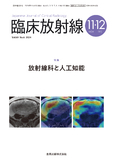Japanese
English
- 有料閲覧
- Abstract 文献概要
- 1ページ目 Look Inside
- 参考文献 Reference
放射性同位元素(RI)を体内に投与して診断,治療を行う核医学は,がんや脳疾患,心疾患など,多くの医学領域において不可欠の医療技術である。例えば,ブドウ糖をフッ素18で標識したフルデオキシグルコース(FDG)を用いたFDG-PET/CTは,がん細胞でブドウ糖代謝が亢進していることを利用してがんを可視化する1)。同じPET/CT装置でも,薬剤をフッ素18標識FMISOに変更すると,低酸素を画像化することができる2)3)。また,フッ素18標識フルテメタモールを使用すると,この分子がアミロイドに結合する性質をもつことにより,脳内アミロイドの多寡を画像化することができる。核種を変えて炭素11標識メチオニンを使用すると脳腫瘍を画像化することができ,特に治療後の再発と壊死の鑑別に有用である4)。一方,ソマトスタチン受容体に対するリガンドをガリウム68で標識した薬剤を使用すれば神経内分泌腫瘍を画像化することができ(分化度によってはFDG-PET/CTよりも病変描出能が高い),同じリガンドをルテチウム177で標識すれば,ルテチウム177から放出されるβ線が神経内分泌腫瘍の細胞を傷害し,ペプチド受容体放射性核種療法(peptide receptor radionuclide therapy:PRRT)と呼ばれる重要ながん治療法の1つとなる。
This article explores the intersection of nuclear medicine and artificial intelligence(AI), highlighting the unique characteristics of nuclear medicine imaging that make it particularly suitable for AI applications. It discusses various AI techniques used in nuclear medicine, including deep learning for anomaly detection in PET/CT scans, image generation, and the potential of large language models(LLM)in report generation and structuring. The manuscript also covers Metavol, a software tool for PET/CT image analysis, and its web-based version under development. The article emphasizes the importance of AI in enhancing diagnostic accuracy, quantification, and workflow efficiency in nuclear medicine, while addressing future directions in this field.

Copyright © 2024, KANEHARA SHUPPAN Co.LTD. All rights reserved.


